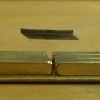Build a Levitating Model Train Track with Magnets
Maglev trains are powered by magnetic levitation technology. If you have ever heard about or ridden on one of these high speed trains, then you may already know that they hover above the track. This is because their design is based on the Meissner effect. When cooled to a super low temperature, superconducting materials like Yttrium-barium-copper-oxide enter a state of zero electrical resistance, expel magnetic fields and can levitate.
You can build your own mini Maglev train and track, with a few simple materials and construction. We have outlined some steps and supplies below, however, this method differs from the Maglev train technology. Read on, and see if you can guess how this design is different.
Supplies
- Self adhesive magnets or rectangular block magnets (at least 4)
- Wooden board or cardboard for a base
- Strips of Plexiglass for guide rail
- Styrofoam or wood for train
- Glue
- Marker
- Ruler or tape measure
Steps
- First, you need to build your track. To do this, lay out your base on a flat surface and glue on plexiglass or clear plastic strips to create guide rails. Make sure to measure these before gluing. They need to be barely wider than the width of your block.
- Mark the north and south poles of the magnets with your black marker. Glue down two of your magnets with the same pole facing up. They should have a space in between and be parallel to each other, like actual tracks.
- Then take your styrofoam or wooden block that serves as your train. Glue magnets to the bottom of your train. It is extremely important to mark these magnet poles and place the same pole up as the train track. Magnets repel against alike poles and it causes the levitation. For example, if North is facing up on your track, then the south pole should be glued to your block, while the North pole is outward.
- Now, you can test out your train on the track. Place your train above the magnets, using the rails to guide it. You can adjust the levitation of the train by using a heavier train material. For instance, using a heavier wooden block may be better with stronger neodymium magnets.

